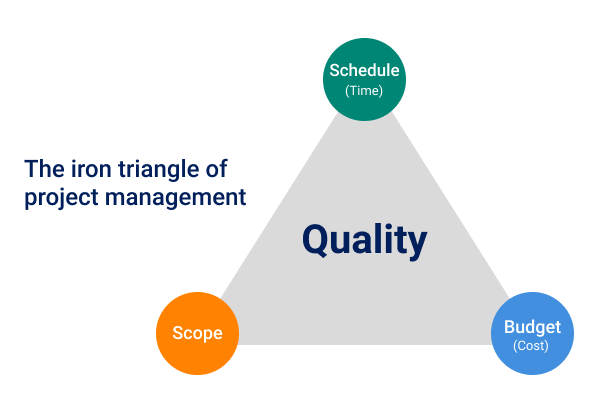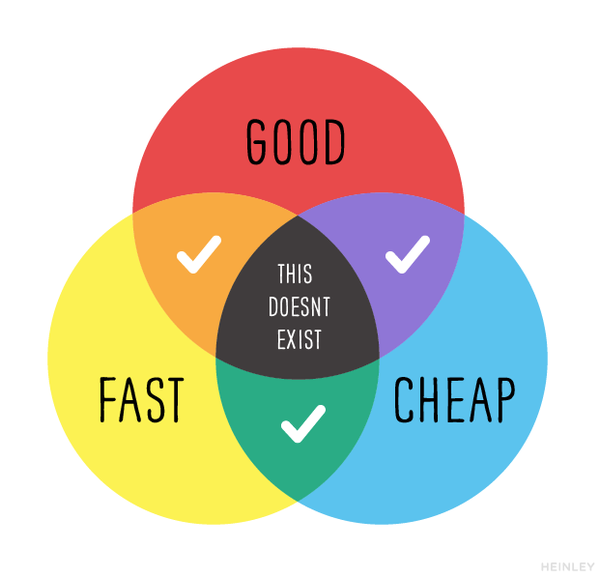The death of the project management triangle


Table of Contents
Table of Contents
If you’re remotely interested in project management, then you’ll likely be quite familiar with the scope-budget-time project management triangle. As with many tried-and-true ideas and theories, sometimes it can be good to hit refresh and come at it from a new angle. And that’s what I’d like to do today—let’s have a look at the project management triangle together, and I’ll share my perspective on why scope-budget-time approach is not only incomplete but also in need of a complete makeover.
Today we’re going to zoom out and see the bigger picture. As I reflect on the current and future state of project management, one thing is clear:
The classic project management triangle is incomplete.
Let’s look at the classic triple constraint approach and see why it’s no longer the best way to approach modern day project management.
You know the one I’m talking about – “Fast, cheap, or good—pick two.”
For decades, project managers have relied on this deceptively simple framework to balance time, scope, and budget. But in today’s complex business environment, this framework is showing its age.
Major projects consistently fail despite rigid adherence to the triangle’s principles. Consider Berlin’s Brandenburg Airport, which opened eight years late and billions over budget. Or London’s Crossrail project, whose completion date was pushed back multiple times while costs exceeded initial funding by $4 billion. Even tech giants aren’t immune—Google’s cloud gaming service Stadia was shuttered after just three years, despite massive investment and scope control.
These failures suggest it’s time to retire the traditional triangle. Here’s why it no longer serves us and what should replace it.

The project management triangle is made up of three variables that determine project quality: Time, scope, and budget.
The triangle demonstrates how these three variables are linked—if one of the variables is changed, the other two must be adjusted in order to keep the triangle connected.
If the triangle breaks—that is, if one point is moved without adjusting one or both of the other points along with it—the quality of the project will suffer.
A project manager’s role is to balance these constraints while staying on budget, meeting deadlines, and delivering on expectations.
Makes sense, right? Well…let’s keep going.

The classic triangle framework assumes projects operate in a predictable environment where trade-offs are straightforward and linear. But modern projects face challenges that don’t fit neatly into this model:
Customer needs and market conditions often change dramatically during a project’s lifecycle.
Tesla’s approach to vehicle development illustrates this well—they make up to 20 engineering changes per week to optimize performance and manufacturing efficiency, with regular over-the-air updates adding features post-delivery.
The traditional triple constraint triangle would view these as scope creep, but they’re essential for success.
Projects today rarely exist in isolation.
When Apple develops a new iPhone, they’re not just creating hardware—they’re coordinating with app developers, managing supply chains, and integrating with their broader ecosystem of services.
Success requires orchestrating multiple systems that the project management triangle framework simply doesn’t account for.
The scope-time-budget triangle assumes linear relationships between constraints, but reality is messier. SpaceX provides a compelling example of shattering these assumed constraints.
When SpaceX entered the market in 2002, the average cost to launch a payload to orbit was approximately $65,000 per kilogram. Through innovative approaches like reusable rockets and vertical integration of manufacturing, SpaceX has reduced this to approximately $2,720 per kilogram with their Falcon 9. Meanwhile, they’ve increased launch frequency and reliability, achieving a 99% success rate over their last 228 launches.
This demolishes the traditional assumption that you must sacrifice either cost, speed, or quality.
Modern projects involve an unprecedented number of stakeholders with diverse and sometimes competing interests.
The traditional project management triangle fails to account for this social and organizational complexity. Consider a major infrastructure project like London’s Crossrail: It must balance the needs of government agencies, local communities, environmental groups, commercial interests, and future users, all while managing the technical constraints.
The scope-time-cost triangle’s simple trade-offs don’t capture these complex stakeholder dynamics that can make or break a project. If you’re still relying on the project management triangle to deliver successful outcomes, it’s time to rethink your approach.
In his influential work, Nassim Taleb introduced antifragility, which is the ability to gain strength from disorder and uncertainty. This concept, when applied to project management, offers a powerful alternative to the rigid constraints of the traditional triangle.
Nassim Nicholas Taleb, author of “Antifragile: Things That Gain From Disorder”
“It is the system and its fragility, not events, that must be studied—what physicists call ‘percolation theory,’ in which the properties of the randomness of the terrain are studied, rather than those of a single element of the terrain.”
While robust systems resist change and fragile systems break under pressure, antifragile project management frameworks actually improve when faced with volatility and uncertainty.
This represents a fundamental shift in how we approach projects. Rather than trying to eliminate uncertainty through rigid planning and control, antifragile project management harnesses uncertainty as a force for improvement.
Here’s how this transforms traditional project thinking:
Instead of starting with “Fast, cheap, or good?”, antifragile projects begin with “What creates the most value?”
This shifts focus from managing project constraints to maximizing outcomes. Heathrow’s Terminal 5 project exemplifies this approach. By prioritizing value creation over constraint management, they implemented real-time production control systems that reduced material replenishment cycles from 24 hours to 2-3 hours while increasing reliability to 98%.
More importantly, this system became more efficient as it encountered and adapted to challenges.
Traditional project management seeks to optimize within known parameters.
Antifragile projects maintain multiple options to benefit from unexpected opportunities. Toyota’s set-based design process demonstrates this principle. They purposefully develop several potential solutions simultaneously, preserving flexibility until the last responsible moment.
This approach appears inefficient by traditional metrics but creates resilience through redundancy. When market conditions or technical requirements change, Toyota can quickly pivot rather than restart their development process.
Instead of trying to predict and control every variable upfront with a “perfect plan,” antifragile projects build systems that adapt to change.
Amazon’s fulfillment network demonstrates this principle. Their logistics system continuously adjusts to changing demand patterns, using automated forecasting and inventory management to optimize efficiency across their entire operation.
Each disruption becomes an opportunity to develop stronger processes.
Traditional project management focuses on efficiently allocating resources—people, systems, and tools. Antifragile project management takes a fundamentally different approach by developing underlying capabilities that actually strengthen under pressure.
This shift requires understanding the distinction between resources and capabilities. Resources are what you have; capabilities are what you can do with them. For example, when SpaceX entered the aerospace industry, they didn’t just hire engineers and buy equipment. They built new organizational capabilities in rapid prototyping, vertical integration, and reusable technology. Each launch, successful or not, strengthened these capabilities, ultimately transforming the economics of space flight.
Capability building works by focusing on the value-adding processes specific to your project type. A software development project requires different delivery processes than a construction project. By optimizing these underlying processes—reducing cycle times, improving decision-making speed, streamlining workflows—you create compound benefits. Shorter cycle times decrease schedule costs. Faster decisions reduce opportunity costs. Better identification processes improve project selection.
The key is measuring and managing these capabilities systematically. This requires robust process management skills and methodologies like tracking cycle times, measuring process reliability, and quantifying value creation. While this might seem abstract compared to traditional resource management, it represents the future of project management and offers the greatest potential for sustainable value improvement.
Moving from traditional project management to an antifragile approach requires a fundamental shift in both mindset and practice.
Here’s how to begin this transition:
Projects aren’t just about completing tasks; they’re about solving strategic business problems. Modern project managers must elevate their thinking beyond traditional constraints to focus on strategic value creation.
Start by asking questions like:
This strategic alignment means sometimes accepting higher costs or longer timelines if they enable greater long-term value. When faced with trade-offs, always prioritize decisions that build long-term capability over short-term efficiency.
Create feedback loops that strengthen your project as it encounters challenges. This means:
The goal is to make your project smarter and more resilient with each challenge it faces.
Systems are everywhere, and we live our lives as part of many of them.
Systems thinking is essential for antifragile project management. This means:
Remember: A project is not just a collection of tasks but a living system of interconnected parts.
The quality of your team and how they work together is the foundation of antifragile project management.
Ed Catmull, co-founder of Pixar
“If you give a good idea to a mediocre team, they will screw it up. If you give a mediocre idea to a brilliant team, they will either fix it or throw it away and come up with something better.”
Building an antifragile team requires four important elements:
Remember: Great teams don’t happen by accident. They require intentional design and leadership that prioritizes long-term capability building over short-term efficiency.
Begin implementing these principles on a small scale:
The key is to view challenges not as threats to be avoided but as opportunities to strengthen your project system. Each disruption becomes a chance to build greater capability and resilience.
The project management triangle served its purpose in a simpler era, but today’s complex projects demand more sophisticated approaches.
The evidence is clear: Major projects consistently fail despite rigid adherence to traditional constraints. What worked for predictable, linear projects of the past breaks down in our interconnected, rapidly evolving business environment.
Antifragile project management offers a way forward. By focusing on building capabilities that strengthen under pressure, maintaining strategic options rather than optimizing for efficiency, and viewing uncertainty as an opportunity rather than a threat, organizations can create project delivery systems that actually improve when faced with challenges.
This transformation won’t happen overnight. It requires big shifts in how we think about project success, how we build teams, and how we measure value. But the rewards—more reliable delivery, better outcomes, and sustainable competitive advantage—make this journey exciting for any organization serious about executing complex projects in uncertain times.
The choice isn’t between fast, cheap, or good anymore. The real question is: How do we build project management systems that thrive on change rather than break under it?
The constraint triangle is dead. Long live antifragile project management.
To deliver a product or service within a specified time and budget you have to juggle a variety of activities, responsibilities, and stakeholders. Estimating the project’s cost and keeping tabs on actual spending are two crucial aspects for project managers. Budget to actual variance analysis is the comparison of the budgeted and the actual cost […]
In this tutorial, learn how to create a budget vs. actuals report in Excel using Power Query. Gain insights and track financial performance effortlessly. As a financial controller, accountant, or CFO, you’re likely familiar with the concept of budget vs. actuals. You know that reporting budget vs. actuals can be both cumbersome and time-consuming, given […]
As artificial intelligence grows in popularity, every company is now competing to launch tools that leverage AI inside their existing apps. Microsoft’s launch of Copilot, an AI assistant tied into the Microsoft 365 ecosystem, plants their flag in the world of AI. It’s no surprise that you might be asking yourself: How can I integrate […]